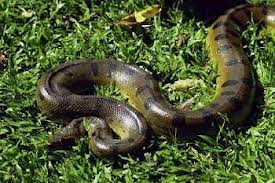Like Indiana Jones, I too have asked that question many times of late. I finally decided to stop trying to figure it out and accept the fact that—to use one of my least favorite clichés—it is what it is. (At the end of the day, of course.)
Okay, the backstory: last July I wrote a Guilty Pleasure post on one of my favorite dumb movies, Anaconda. That’s the “B” movie chock full of “A”-list stars: Jennifer Lopez, Jon Voight, Owen Wilson, Ice Cube. Subsequently I noticed a considerable number of people finding my blog by inputting some form of the word “anaconda” into the various search engines. Hmm, interesting…
So the following month I wrote another post on the film’s sequel, Anacondas: The Hunt for the Blood Orchid. (That’s the title; really.) No “A”-listers in this one, but it is watchable…fun, but ultimately forgettable. Since then, some variation of “anaconda” has been number one in sending people to this blog. Nothing is even close.
Here are some numbers: during the past thirty days alone there have been over two hundred searches. Besides “anaconda” and “anacondas” there are words and terms such as, “anakonda,” “anaconda movie,”  “anaconda film bilder,” “giant anaconda,” “anaconda movie photos hot,” “how anaconda kill a man,” “anaconda geant le film,” “anaconda kills Owen Wilson,” “giant snake movie,” “where in anacondas 2 is kadee strickland’s thong slip,” “the big snake movie by jinefer (sp) lopez,” “anaconda eating person,” and so on.
“anaconda film bilder,” “giant anaconda,” “anaconda movie photos hot,” “how anaconda kill a man,” “anaconda geant le film,” “anaconda kills Owen Wilson,” “giant snake movie,” “where in anacondas 2 is kadee strickland’s thong slip,” “the big snake movie by jinefer (sp) lopez,” “anaconda eating person,” and so on.
One question I can’t answer is this: were the folks doing the search interested in the movies, or in the snake itself? Probably some of both, I imagine. That also got me wondering, why the fascination with anacondas? So here are some real factoids.
The anaconda, sometimes called a water boa, is a large, non-venomous snake found primarily in the Amazon and Orinoco river basins of South America. It usually hangs out in murky water and swims a whole lot faster than it can slither along the ground. (When you see one racing on land in the first movie, chalk it off to creative license.) Contrary to the high body count in the first two films (and probably higher in the sequels, which I have so far avoided), anacondas prefer to chow down on turtles, caimans, birds, fish, even the occasional deer that wanders too close to the river.

“Uh, guys, what do we do with it now?”
The “giant anaconda” of South America is a myth, although these suckers are not exactly on the petite side. The more common green anaconda can weigh anywhere from a few hundred pounds up to half a ton, with a length of thirty feet or more. When they consume a big meal, such as a land animal, it can take them weeks to digest it. The females are larger than the males, and they give birth to anywhere from two to three dozen live, squirming baby snakes at one time. (Betcha Indiana Jones would love to be in the midst of that!)
Anyway, this blog is no substitute for National Geographic or Animal Planet. I’m sure you can learn a lot more about anacondas online, if you so desire. I just thought that all those searches leading to my blog (kadee strickland’s thong slip???) were interesting.
SWORDS & SPECTERS: for a good scary weekend I’m offering my Native American-themed horror novel, The Modoc Well, free for downloading on Amazon Kindle. One of my  gorier stories, the plot chronicles the rebirth of a violent Modoc Indian demon, first through the ill-fated Padgett family in the 1850s, then again through their descendants. As one reviewer noted: “The Modoc myth provides the historical element of this tension-filled novel. But it is Sirota’s superb ability to tell a story that provides the entertainment. Highly recommended.”
gorier stories, the plot chronicles the rebirth of a violent Modoc Indian demon, first through the ill-fated Padgett family in the 1850s, then again through their descendants. As one reviewer noted: “The Modoc myth provides the historical element of this tension-filled novel. But it is Sirota’s superb ability to tell a story that provides the entertainment. Highly recommended.”

OK, color me surprised that anacondas would be a big draw to your blog. I’m sure that a discussion about writing (even if it includes guilty pleasures such as “Anaconda”) isn’t what they were expecting. Hopefully some stuck around for more. As a side note, that is a great picture you found of the snake!
KaDee Strickland’s thong? In rebuttal I would offer the vision of Salma Hayak, in “From Dusk Till Dawn” dancing on the table wrapped in what looks like a python. It was not meant for my personal pleasure, but I completely understand how something that sexy could change anybody’s opinion of snakes…except hers, of course. They terrify her, poor thing.
I really enjoyed, “The Modoc Well”. And yes, it is one of your more gory stories, so those who enjoy that aspect of horror will particularly like that. Generous of you to give people a taste of your work. I highly recommend they take advantage of the opportunity.
And if you want to get involved in the snaky-horror genre yourself, all I can say is look no farther than the currently on-going Florida Everglades Python Challenge 2013, a month-long event sponsored by the Florida Fish and Wildlife Conservation Commission, which is “open to hunters and non-hunters alike”.
Yes, siree. For a mere pittance in prize money, clueless amateurs are being turned loose in the swamps of Florida to track down the ecologically disastrous invasive python that threatens virtually every native animal species down there…including the hunters, it would seem.
As one potential hunter said, “I was hoping there would be a lot of machetes and not a lot of guns” because “these idiots will be firing all over the place.”
Shawn Heflick, star of the National Geographic television show “Python Hunters” told Reuters that, despite the formidable size of the snakes, he expects the swamp itself, with its alligators, crocodiles and venomous snakes, to pose a greater threat to the contestants. “You get these people going down there, they’ll get lost, they’ll get dehydrated, they’ll get sucked dry by mosquitoes.”
Oh, Mike, I can see your next book practically writing itself, can’t you?
With all those critters and vermin down there, I’m seeing a virtual gore-fest for the next book! 🙂 Thanks for pointing it out. I wonder what the body count in Florida will turn out to be. Doofuses, not pythons! 🙂
It’s really too bad that pythons are shy, retiring types. I would love to bet against the doofuses, but that would also be a bet against everything else trying to make a home in the swamps.
I’m still keeping my eye on the body count, on both sides. 🙂
Also the very famous (in some circles) Anaconda copper mine in western Montana and the name of a huge sporting goods chain in Australia. Anacondas in FL are under a reign of terror.
You could be right, Pat…but I think it still had to be snakes. 🙂